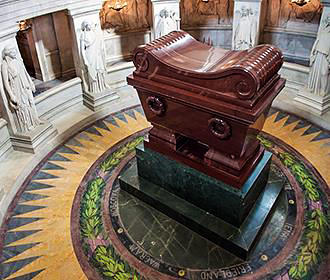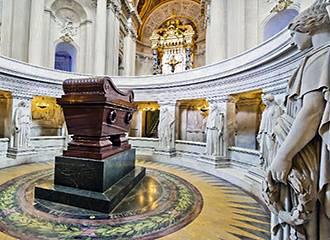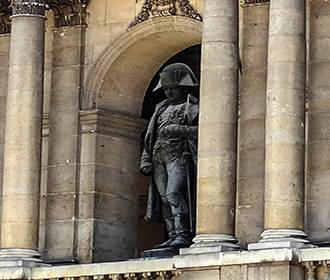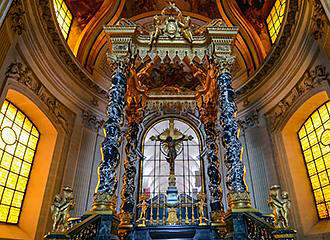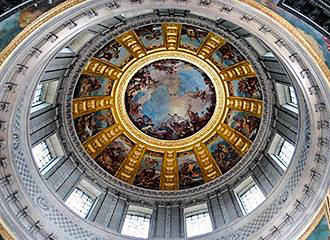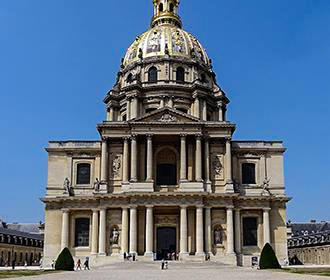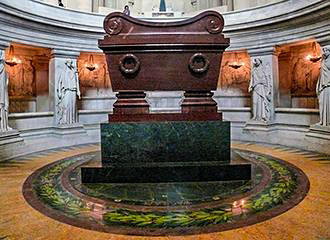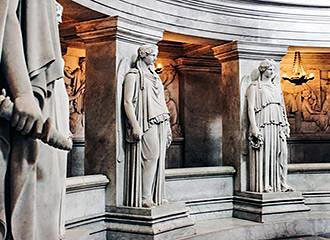Paris Tomb of Napoleon Bonaparte I at Les Invalides
Les Invalides is one of the fascinating Paris monuments that is a popular place to visit when you are on holiday in Paris. Not only do you get to see the impressive building and experience the history of Les Invalides, but also you can visit the Tomb of Napoleon Bonaparte I and the Musee de l’Armee, which is home to the third largest collection of antique armour and arms in the world.
So although most people have already heard of Napoleon, we thought we would provide a little bit of history on Napoleon Bonaparte I, before we look at the crypt and the Tomb of Napoleon.
Napoleon Bonaparte I
Napoleon Bonaparte I was born on the island of Corsica in 1769 and educated at military school including at the Ecole Militaire in Paris, he rose through the ranks and became commander of the French army in Italy where he forced Austria and their allies to make peace.
A few years later there was a new threat to France when Austria and Russia allied themselves with Britain and Napoleon Bonaparte I returned to Paris because the French government were in crisis.
Then in 1800 Napoleon Bonaparte I and his army defeated the Austrians and negotiated a peace treaty with Europe that meant France had the controlling power and from this he was then made a Consul for life, became the Patron of Les Invalides, or Hotel National des Invalides, plus he oversaw the creation of the Bank of France, the centralisation of the government and the re-instatement of the Catholic religion.
But in 1803 Britain had resumed war on France, then in 1804 Napoleon Bonaparte I was made Emperor and rather than trying to invade England after the defeat at Trafalgar in 1805, he focused on Austria and Russia, and was victorious after the Battle of Austerlitz in 1805, gaining a large territory that gave him control of Europe.
In fact, it was after this victory that Napoleon Bonaparte I decided upon a triumphal arch that his armies could march through on their way home to Paris and this is why the famous Paris monument called the Arc de Triomphe was constructed at the Place d’Etoile, which is now called the Place Charles-de-Gaulle that is one of the largest intersections you will find anywhere.
The Holy Roman Empire was then dissolved and over the next few years Napoleon Bonaparte I put family members and loyalists as leaders of countries like Spain, Italy and Holland. However, after the Peninsular War began in 1808 and the costly defeats of the French over the next few years, this drained the resources of France dramatically.
Paris itself then fell in 1814 and Napoleon Bonaparte I went into exile on a Mediterranean island, but in 1815 he escaped and marched on Paris, yet the Battle of Waterloo ended his short second reign and he was imprisoned on the remote Atlantic island of St Helena by the British.
It was on this remote island that Napoleon Bonaparte I died on the 5th May of 1821 at the House of Longwood and was buried a few days later on the estate of Mr Richard Torbett close to a spring. Even though Napoleon Bonaparte I had originally planned a funeral at the Saint Denis Basilica just outside of Paris where lots of past French Kings were laid to rest, just before his death he then requested that he be buried on the banks of the River Seine so that he could be amongst the French people. But obviously this never happened.
In fact, his remains were on the island of St Helena for almost twenty years and it had taken King Louis Philippe around seven years of negotiations with the British government in order to bring back his remains to Paris so that Napoleon Bonaparte I could at long last rest in peace.
The burial of Napoleon Bonaparte I
It was in 1840 that King Louis Philippe ordered the remains of Napoleon Bonaparte I to be returned to Paris from the island of St Helena and the Italian born French architect Louis Visconti was chosen to create the tomb that would be positioned within the Eglise du Dome in the historical military complex, Les Invalides, located in the heart of the capital city of Paris, even though originally it was discussed that he should be buried at the Pantheon.
A commission was formed that would sail to St. Helena in order to bring back the remains of Napoleon Bonaparte I to France and the leader of the expedition was Francois, Prince of Joinville, who was a son of King Louis Philippe.
The frigate named La Belle-Poule, left France on 7th July 1840 and arrived at St Helena on 8th October 1840, then one week later the commission dug up the emperor's coffin and made preparations for the return journey to France.
La Belle-Poule docked at Le Havre in the beginning of December 1840 and the Emperors coffin with his remains was transported over the River Seine to Courbevoie, which is a suburb, also known as a commune, of Paris.
Then not long after on 15th December 1840 the state funeral for Napoleon Bonaparte I was held in Paris, and during the procession Napoleon's coffin rested briefly under the Arc de Triomphe, which was built on the orders of Napoleon in 1806, but as you can discover from the history of the Arc de Triomphe Napoleon Bonaparte I never saw this Paris landmark completed.
The coffin and procession then went down the famous avenue, the Champs Elysees, across the River Seine and on through the park to Les Invalides.
However, the funeral monument took more than twenty years in production and was not completed until 1861, so Napoleon Bonaparte I was interred there the very same year of completion.
Les Invalides Tomb of Napoleon Bonaparte I
The tomb of Napoleon Bonaparte I is located within a circular crypt in the Eglise du Dome within the Hotel National des Invalides, which had to undergo some major transformations through the visions of the architect Visconti, including the design of the gallery that runs all the way round with sculptures on the walls that depict Napoleon Bonaparte I civil achievements and these were all produced by the sculptor Pierre-Charles Simart.
The body of Napoleon Bonaparte I rests in five successive coffins, which were made of tin, mahogany, lead, lead again and ebony, and these are held within the sarcophagus positioned in the middle of the crypt at Les Invalides.
The sarcophagus itself is made out of red quartzite from Russia and positioned on a green granite base that came from the Vosges mountains in the Alsace region of France, and it is circled by a crown of laurels and inscriptions.
You will also get to see the military victories that are depicted around the tomb of Napoleon Bonaparte I in the form of sculptures by Jean-Jacques Pradier and there are eight famous victories that are inscribed on the polychrome marble floor.
On the side of the crypt there is a small chamber with a statue of Napoleon Bonaparte I in his coronation robes, which was made of marble by the sculptor Pierre-Charles Simart and underneath this statue are the remains of his only legitimate son Napoleon II, who was also known as The Eaglet.
There are many additional tombs and funerary monuments located within the Les Invalides Eglise du Dome, and you can discover more about this along with the plans and layout by going to our dedicated page of how to get to Les Invalides, which includes PDFs that can be downloaded for many different aspects of what you can see at this historical landmark, along with Paris public transport options.
So when you are on holiday in Paris a visit to Les Invaldies and the Tomb of Napoleon Bonaparte I is not just a fascinating experience with its rich French history, but you can also get to see the Musee de l’Armee, artillery collections at the Court of Honour and much more including an additional two museums on top.
Visiting Les Invalides Tomb of Napoleon Bonaparte I
Obviously, as you have already gathered, the tomb of Napoleon Bonaparte I is located within the Hotel National des Invalides within the former royal church designed by Jules Hardouin Mansart called the Eglise du Dome.
However, the price for admission not only includes the Tomb of Napoleon Bonaparte I, but also the Musee de l’Armee with its many different sections, the Musee des Plans Reliefs and the Musee de l'Ordre de la Liberation, which is a cost of €14 as of 2020.
From the start of October through to the end of March the tomb of Napoleon Bonaparte I is open from Monday to Saturday 10am to 5pm and on Sunday from 10am to 5:30pm.
However, for the rest of the year it is open daily from 10am through to 6pm, yet there is also a late night opening on a Tuesday evening until 9pm when there are temporary exhibitions being held.
Although we would like to point out that the Hotel National des Invalides or Les Invalides is closed on all National French holidays, which include the 25th December, 1st January and the 1st May and the Historical Charles de Gaulle is closed each Monday.
There are two reception desks and the North reception desk is by the Esplanade des Invalides and the South reception desk is by the Place Vauban.
When it comes to getting to Les Invalides via Paris public transport, you will find that the nearest train and Metro station is called Invalides serving Metro lines 8 and 13 along with the RER C train line.
Additionally, the bus lines 28, 69, 73, 83, 87, 93 and several others, not forgetting the Noctilien night buses via the lines N01 and N02 will also get you within walking distance of this incredible Paris tourist attraction, as will the Batobus River Seine water bus and the sightseeing tour buses of Paris TootBus tours.
